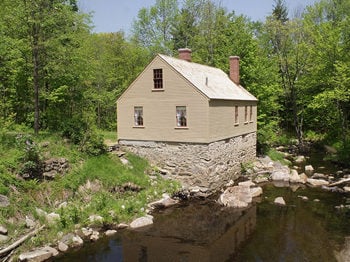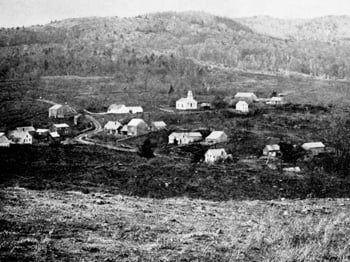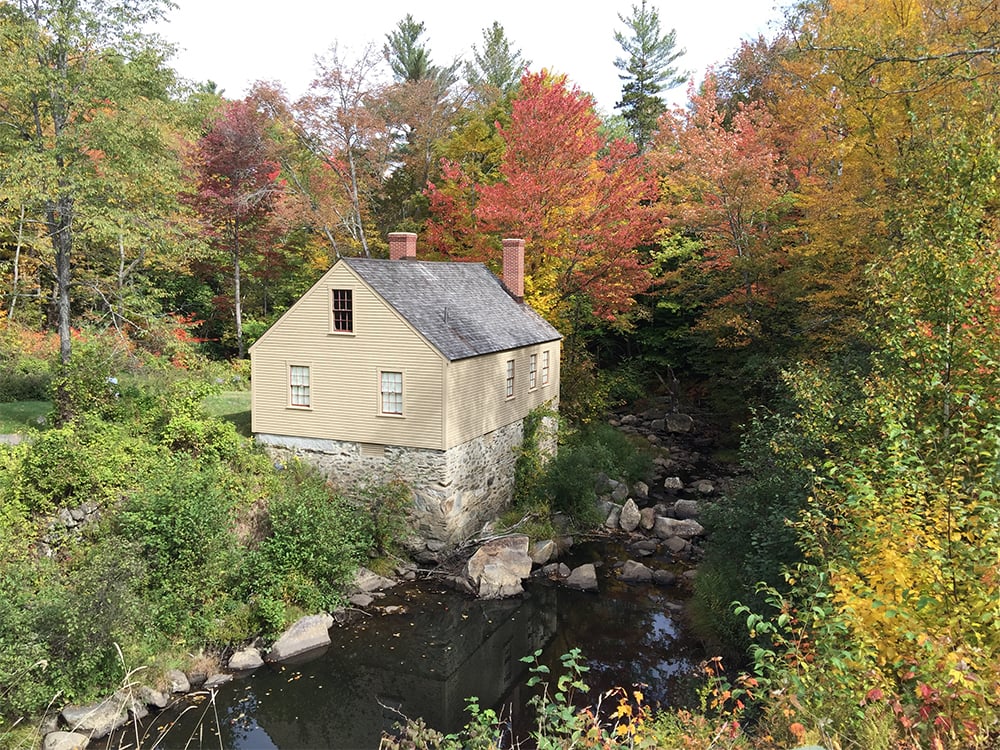 Part I
Part I
Mary Baker Eddy, then Mrs. Patterson, lived in what is now the Mary Baker Eddy Historic House in North Groton, New Hampshire from 1855 to 1860.1 The Quarterly News has previously published the reminiscences of George J. Cummings, who lived in North Groton as a boy in the mid-nineteenth century.2 This present article traces local history both prior to and subsequent to this period and provides illustrations of the changes that have occurred.
The casual visitor to North Groton may not appreciate the changes that have occurred in this little community over the two hundred years since the settling of the town of Groton in 1770. It is today a small cluster of houses, mostly old, a few new, hidden if not isolated, in the hills southwest of Rumney Village. Visitors to the Mary Baker Eddy Historic House in North Groton, maintained by Longyear Historical Society, have frequently enquired about the history of the area and have asked what it was like when Mrs. Eddy lived there.
North Groton is a section of the town of Groton, about five miles from the present center of the town, in Grafton County. The original grant for the town was made on July 8, 1761. Groton was first called Cockermouth, after Cockermouth in northern England, until December 7, 1796 when the town was incorporated.
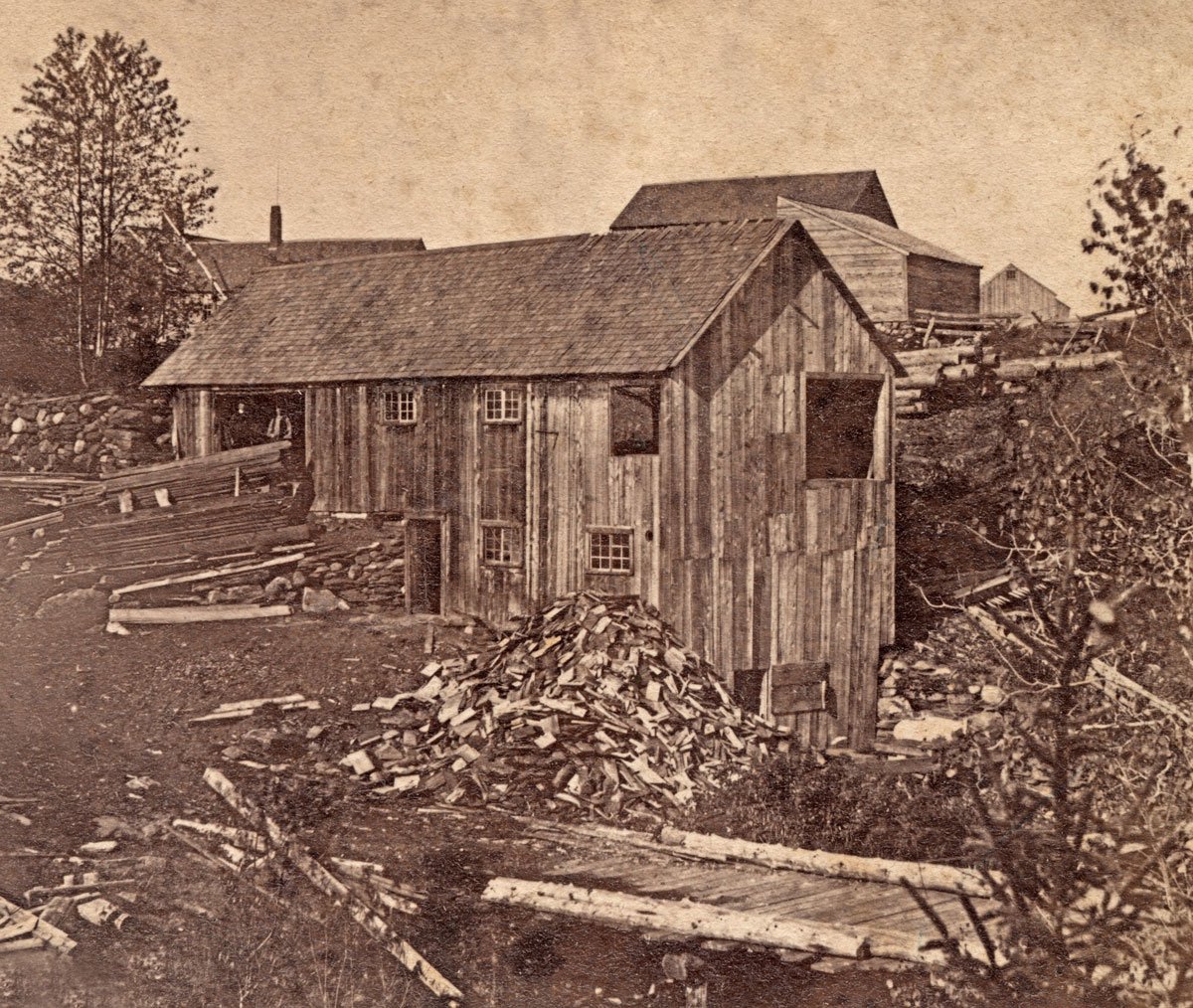
The terrain is very hilly or mountainous with the highest promontory 2182 feet, close to the Dorchester town line to the west. To the north is Bailey Hill and to the east Fletcher Mountain, also over 2000 feet high. Hall’s Brook flows through the center of North Groton where the roads from Groton center, Rumney and Cheever join. The brook was dammed years ago to provide waterpower for mills in the town, and a sluiceway can be found , although the exact location of the dam, or dams, is uncertain. The remains of a water wheel which transmitted power to one of the mills can still be located among the rocks in what was undoubtedly the tailrace, a hundred feet to the north of the Historic House. (Across from the Patterson house was the sawmill in which Dr. Patterson, an itinerant dentist, had invested.)3 The stream, which is now undammed, flows generally northward and empties into the Baker River in Rumney. The road downhill beside the brook has been quoted in a nineteenth century gazeteer as being “one of the most picturesque drives in the county.”4 This evaluation is reasonably accurate today, particularly in the fall color season. It was down this road that Mrs. Patterson went in a carriage one day in March 1860 with her sister, Abigail, to begin her stay in Rumney.5
The brook itself has changed course over the years due to flooding and subsequent erosion and also because of the removal or addition of man-made dams and bridge abutments. For example, photographs of Hall’s Brook taken about 60 years ago show lack of serious bank erosion near the Historic House and a course for the brook considerably farther away from the house foundation than at present.
This section of Grafton County was undoubtedly heavily wooded in the eighteenth and early nineteenth centuries, since lumbering was an important industry during that time. By the 1850’s when Mrs. Patterson lived there, a neighbor later remembered that “the country was one large farm divided into many small ones and each farm owned, occupied and cultivated by a thrifty and intelligent farmer. Where the land is now (1906) grown up to brush, three fourths of it was cleared and in a high state of cultivation.”6 We know from photographs taken in the latter part of the nineteenth century that by then much of the North Groton land was cleared land. Again the 1886 gazeteer tells us that the principal crops at that time were “corn, oats, potatoes and buckwheat.” There has been significant change in the town since then; most of the tilled land has reverted to forest and undergrowth.
In 1773 there were 107 residents of the town of Groton. By 1840 the town had grown to 870 people, but after that there was a slow decline until, in 1890, the population was only 464 , a 47% reduction from the peak. Records show that when Mrs. Patterson lived in North Groton there were, in 1856, 776 people in the town. Today the permanent population is about 200. In the summer there is some influx of vacationers who have built cottages in the town, several along Hall’s Brook and elsewhere in North Groton. There are also a few mobile homes used by both all-year and summer residents. In the immediate area of the Historic House, it is fair to say that now the summer cottages outnumber the all-year homes.
In 1885 there were seven schools in Groton. Today the children are all bused to Bristol and Hebron as there are no schools open in the entire town. The only school building still standing in North Groton is now used as a dwelling and antique shop. It was here that Mrs. Patterson’s son, George Glover, attended school in the 1850’s. (George at this time was living with the Cheney family rather than with his mother.)7 Except for the schoolhouse, there is only one other public building remaining in North Groton. It is the Groton town hall, referred to as the Groton Town House. Construction of the building was begun in 1796 and was completed in the early 1800’s. It is still in use by the town and is located near the North Groton crossroads, which was the original center of the town.
In 1779 a Congregational church was established in Groton, and Rev. Samuel Perley, a graduate of Harvard, was its first pastor. The Union Church in North Groton was built in 1840 by “Congregational, Baptist, Free Will Baptist and Methodist denominations.” It was a “neat wooden structure capable of seating 200 persons . . . valued, including grounds, at $2,000.”8 As chronicled in the Spring 1970 Quarterly News, the church fell into disuse in 1874, although infrequent services were held there until 1955. During the late 1850’s Mrs. Patterson occasionally led the congregation in prayer there. It is for this reason that the church was maintained by Longyear Historical Society beginning in 1966 until the destruction of the entire structure in an unusually heavy snowstorm in 1969. Some items saved from the church, including its bell, are on display in the Mary Baker Eddy Museum. A granite marker erected by Longyear later on the site provides a brief history of the church.9
There is currently no industrial activity in North Groton and little farming. This is in contrast to the situation in the nineteenth century when lumbering was important, maple sugar was produced from “sugar orchards,” and mica was mined. North Groton also had a store, machine shop, lumber mill, cider mill and blacksmith shop. The lumber mill produced shingles and clapboards and had a capacity for cutting 5000 feet of lumber per day. It is interesting to note that the first mill of any kind in the town was erected on Hall’s Brook in North Groton in 1771, before the Revolutionary War, apparently quite near the Historic House.
The mills, the store, and the shops are all gone, as are many houses. The possibility exists for tracing the location of some of those early buildings through county records, as a few foundations still exist. Boundaries of properties were rather loosely defined in previous centuries in terms of trees, fences or stone markers which no longer exist or have subsequently been moved.
As was mentioned, mica mining became an important industry in Groton, as well as in other sections of New Hampshire. There has been little recorded about mining activity in the period Mrs. Patterson lived in North Groton, just prior to the Civil War. It would seem it was not nearly as important then to the community and its economy as the raising of crops, lumbering, or milling operations. The busy, undoubtedly noisy, little town at that time is in contrast to the slumbering but picturesque countryside one now sees.
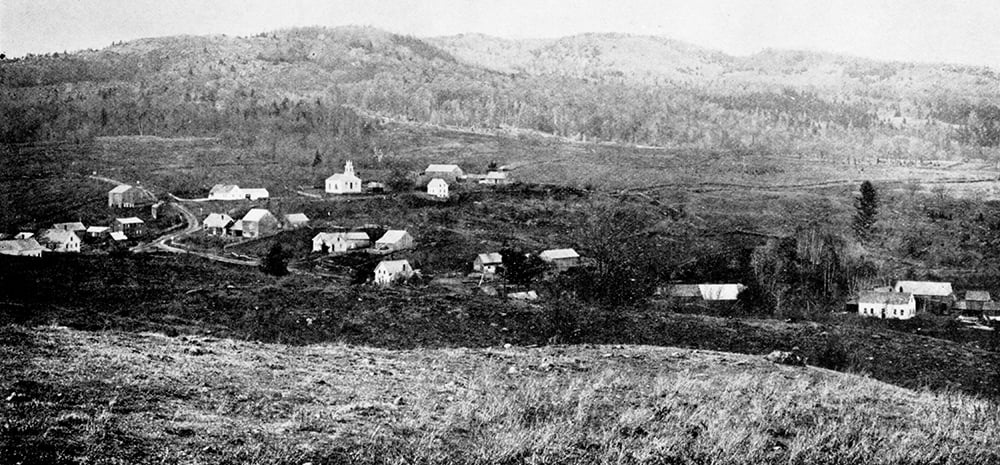
But the sleepy little town may change yet again. Now its natural beauty beckons the summer visitor. Who knows what potential resources may be developed by man which will stir Groton’s past and project it into the future? The Mary Baker Eddy Historic House by North Groton’s brook continues to be a link to the town’s past but, more importantly, it is a memorial for posterity, commemorating the footsteps of that gallant woman who became the Discoverer and Founder of Christian Science.
Part II
The town of Groton was once considered the “greatest mica producing district in the country.” For this reason it was felt a brief description of this activity would be of interest to our readers.
Mica mining is believed to have begun in Groton fairly early in the nineteenth century. By the 1880’s there were at least thirty named mines in this small town, a number of them just a mile or two from the North Groton crossroads and the Historic House. There is practically no mining in progress now, but some of the mines were reopened for short periods up to the 1950’s.
The Palermo Mine in Groton, which mined mica, beryl and phosphates, at one time had 85 miners and 25-30 “trimmers.” This mine had a 400 foot shaft and a 40,000 square foot floor at the bottom. The Valencia Mica Mining Company employed 70 men in 1886. Production was at the rate of 1400 pounds per day.
Mica was used for windows, in stove and furnace doors, goggles and lamp chimneys. In the twentieth century uses for mica have developed for insulation, measuring instruments, and electrical and electronic equipment. Ground mica is also used in the manufacture of paints, wallpaper and lubricants.
The two most common forms of mica are muscovite (light colored), so named because it was used extensively in Russia for windows, and biotite (dark colored). Semi-precious stones are frequently found along with the mica, such as garnet, quartz, beryl and lazulite. Most of the mines are named after their owners or discoverers. Two large companies even show up on the list: General Electric and Eastman. The former had a processing plant not far from the cemetery on the road to Cheever.
For those interested in seeing a mica mine, the Ruggles Mine in Grafton, near Groton, is open to the public daily between June and October. Commercial production of mica is believed to have begun in this mine in 1803. Sam Ruggles was said to have originally kept his mining operations a secret, taking the mica at night by horse and buggy, or horse-drawn sleigh in the winter, to Portsmouth, where it was shipped to England and sold by relatives there. It is estimated that since 1803, thirty million dollars worth of feldspar, mica, beryl and other minerals have been taken from this mine alone.
Mary Beecher Longyear herself took some interest in the North Groton mines, principally because her husband, John, was a mining engineer and had been instrumental in the development of mines in the Upper Peninsula of Michigan. In August 1926 Mrs. Longyear and her twin sister, Abby Beecher Abbott, spent a week living in the North Groton Historic House, which Mrs. Longyear had had restored. While there they visited one of the local mica mines. Mrs. Longyear has left us a delightful account of this excursion, and excerpts of her rather flowery prose are entertaining and descriptive.
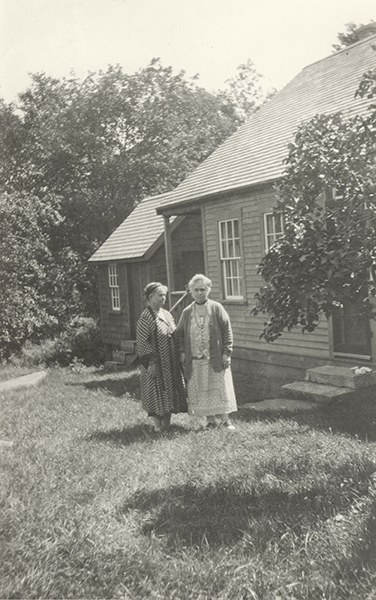
Her article is entitled, “Why Go Abroad?” and the introduction reads like a brochure from the New Hampshire Chamber of Commerce.10
“Many Americans pine to travel abroad and see the wonders and beauties of foreign places, and yet a thrill can be received and a lasting impression made even in this country by an automobile ride through the sparsely settled northern parts of New Hampshire and Vermont of our own country. To visit the mica mines of New Hampshire between Rumney and Groton is an experience long to be remembered.”
To reach the mine, the two women were driven along a wood road as far as possible, where they left the car and chauffeur and continued on up the hill on foot. Their way was suddenly blocked by a team of horses pulling a “rattling wagon containing a big load of diamond sparkling rocks of mica and feldspar.” The teamster advised them they were on the right road. As they neared the summit they were surprised to see “a good-looking young man standing in the door of a small building from which issued the roar of machinery.” Apparently the young man was equally surprised to see the ladies. Far down below in the mine the miners were “chopping out big chunks of luminous silvery rocks.”
Inside, reflections from the glistening mica caused such a silvery light as to make one of the visitors ask under her breath, “Where are the angels?” They sat down while the “more practical” one read a definition of mica and an explanation of its uses. The foreman appeared, and very courteously expanded on the description of the minerals and the mining process.
By this time they were joined by the chauffeur, who apparently felt uneasy with them out of sight. The visitors were led into the depths of the mine and then onto the hilltop overlooking the mine. While this was done with some trepidation, they had trust in the foreman “who had spent his many, many years on the dizzy verge of tin mines, zinc mines abroad, and copper mines in Calumet, (and) to think of falling was an insult….”
“Laden with specimens of mica, feldspar and rose quartz as evidences of their adventure, the tourists re-echoed their appreciation for the gentle courtesy of the American miner, and hoped the United States would protect and use home products and not send to India for the mica for their coal stoves and electrical supplies.
“It is well to remember as some unknown writer has said:
‘The beauty which old Greece
or Rome
Sang, painted, wrought,
lies close at home.’ “
